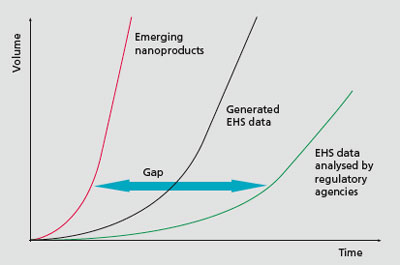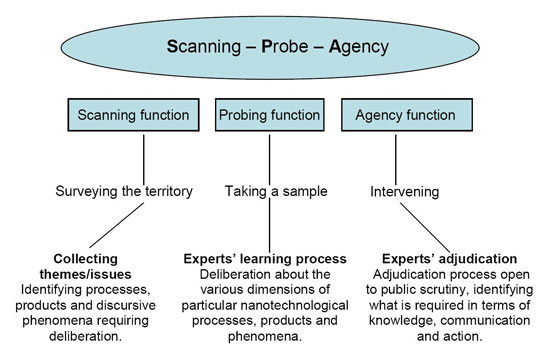| Posted: Dec 12, 2008 | |
The Scanning Probe Agency - embedding nanotechnology developments in society |
|
| (Nanowerk Spotlight) The last few days alone have seen a flurry of press releases about new reports and research papers on controversial societal aspects of nanotechnologies: A National Research Council committee in the U.S. issued a highly critical report describing serious shortfalls in understanding the environment, health and safety (EHS) risks of nanotechnology and to effectively manage those potential risks; law experts ponder keeping up with technology; a study finds that, rather than infer that nanotechnology is safe, members of the public who learn about this novel science tend to become sharply polarized along cultural lines; and that in some countries, nanotechnology appears to fail the moral litmus test of religion. And this was just during the past week. | |
| Key to the successful development and public acceptance of nanotechnology-enabled products are effective plans, on national and international levels, for identifying and managing potential risks. As the Royal Commission on Environmental Pollution has stated in its recent report (Novel Materials in the Environment: The case of nanotechnology), the pace at which new nanomaterials are being developed and marketed is beyond the capacity of existing testing and regulatory arrangements to control the potential environmental impacts adequately. | |
 |
|
| Schematic representation of the gap between the emergence of products containing nanomaterials in comparison to the generation of environmental health and safety data (EHS) and their subsequent use by regulatory agencies. The diagram is purely qualitative. (Source: "Novel Materials in the Environment: The case of nanotechnology", p.30) | |
| A new report prepared for the German Federal Ministry of Education and Research (BMBF) outlines an institutional model that meets the safety and security demands of human health, the environment and society. Prepared by the nanoOffice at the Technical University Darmstadt, the report draws on an analysis of national and international approaches to nanotechnology regulation. | |
| According to the authors of the report, Andreas Lösch, Stefan Gammel and Alfred Nordmann, one of the key findings is that in the case of developing nanotechnologies, the place of classical regulation has been taken by precautionary measures such as observatories, voluntary codes of conduct and stakeholder dialogues. | |
| The authors write that, "by themselves, these cannot meet the challenges posed by nanotechnologies, nor do they satisfy the need for regulation. These soft measures of an expanded notion of regulation and precaution do not provide what classical regulation has to offer, namely public oversight, political transparency and legal certainty – guaranteed by a publicly accountable institution. A generalized precautionary approach thus also signifies a surrender of the political option of intervention. However, the option of influencing processes of innovation is indispensable for responsible, circumspect and socially robust action with regard to the uncertainties associated with emerging nanotechnologies." | |
| Nordmann and his colleagues suggest the development of an institutional model, which they have facetiously called the Scanning Probe Agency (SPA), as both a necessary and appropriate collective learning process and a means of generating public trust. Its guiding question would be: "Is nanotechnology in good hands?" | |
| Explaining the name, this model contains three basic functions, which can be summed up in terms of surveying the terrain, conducting hearings on selected issues and elaborating recommendations in a collective and publicly transparent manner.: | |
| 1) A scanning function for broadly surveying the field of scientific-technical developments and identifying those innovations, products and discourses that require clarification; | |
| 2) a probing function for selecting specific issues and conducting communication about their various dimensions within a "learning community of experts"; sample probings will be conducted by means of testimonial hearings (involving witnesses from research, official authorities, industry, etc.); | |
| 3) an agency function for conducting public, court-like adjudication procedures, for intervening in debates and for devising socially robust recommendations that specify, for example, the need for action on the part of other regulatory authorities as well as deficiencies in research and communication. | |
 |
|
| Functions of the nanotechnology SPA | |
| It is important to note that what the German scientists propose is not like a scientific institute or a regulatory body but more like a think tank, or as the authors call it, a learning community of experts from all areas of society – academia, industry, the unions, churches, NGOs, consumers etc. "The task of this community is to formulate judgments on selected nanotechnological products, processes and discursive phenomena and to present these judgments in public, while also giving a clear indication of where the limits to existing knowledge lie." | |
| While the SPA itself would not perform regulatory functions or conduct any research of its own, it instead would derive new insights on the basis of selected case studies. The major purpose of the SPA would be to open up research results from laboratories and commercial product development to public scrutiny and, where required and justified, make recommendations such as research support for desired innovations or regulatory precautionary measures in the case of products deemed to give cause for concern. | |
| This interesting model arises from the requirements of the Zukunftsforum Nanotechnologie (Nanotechnology Forum for the Future), envisaged by the German federal government for a deliberate and interdisciplinary dialogue. | |
| According to its proponents, the establishment of an SPA would create an official institution in the position of mediator that is both responsive to public concerns and politically transparent and which would be able to provide ongoing support for and critical assessment of, among others, the projects that are part of the Nano-Initiative-Aktionsplan 2010, such as the Nano-Dialog initiated by the Federal Ministry for the Environment, Nature Conservation and Nuclear Safety (BMU), the Federal Ministry of Education and Research (BMBF) project NanoCare, the working groups of the Federal Ministry of Labour and Social Affairs (BMAS), the consumer protection measures instituted by the Federal Institute for Risk Assessment (BfR), as well as the public information activities of BMBF campaigns such as Nanotruck. | |
| While the full, 90-page report is available only in German (Observieren – Sondieren – Regulieren. Zur gesellschaftlichen Einbettung nanotechnologischer Entwicklungsprozesse), a comprehensive summary is available in English. | |
 By
Michael
Berger
– Michael is author of three books by the Royal Society of Chemistry:
Nano-Society: Pushing the Boundaries of Technology,
Nanotechnology: The Future is Tiny, and
Nanoengineering: The Skills and Tools Making Technology Invisible
Copyright ©
Nanowerk LLC
By
Michael
Berger
– Michael is author of three books by the Royal Society of Chemistry:
Nano-Society: Pushing the Boundaries of Technology,
Nanotechnology: The Future is Tiny, and
Nanoengineering: The Skills and Tools Making Technology Invisible
Copyright ©
Nanowerk LLC
|
Become a Spotlight guest author! Join our large and growing group of guest contributors. Have you just published a scientific paper or have other exciting developments to share with the nanotechnology community? Here is how to publish on nanowerk.com.
